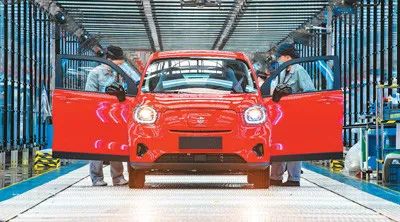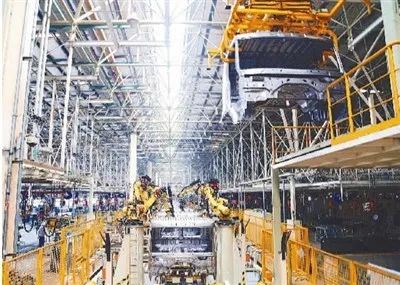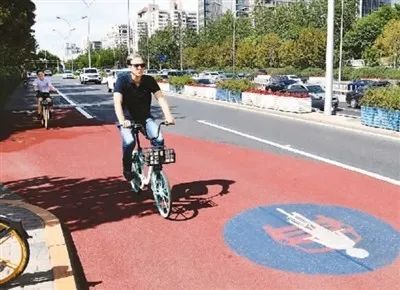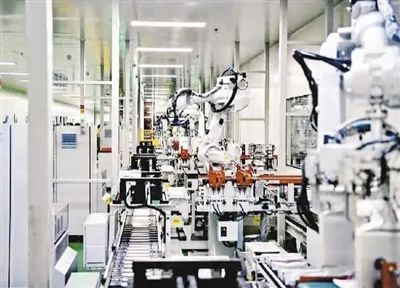The road to green travel China is getting wider and wider

On April 26th, in the workshop of Zero Run Automobile Co., Ltd. in Jinhua New Energy Vehicle Town, Zhejiang Province, new energy vehicles were orderly taken offline.

On February 28th, a fully welded automatic robot completed the process of welding the cab of a new energy vehicle at a factory in Ma’anshan City, Anhui Province.

The bicycle priority sign is set up after the upgrade and renovation of the slow traffic system on the East Second Ring Auxiliary Road in Chaoyang District, Beijing.

On February 19th, in the workshop of a new energy vehicle lithium-ion power battery production enterprise in Ganzhou City, Jiangxi Province, the intelligent power battery production line was operating in an orderly manner.
In Nanning City, Guangxi Zhuang Autonomous Region, since the introduction of new energy buses, the noise in the city has decreased and the passenger experience has become more comfortable; In Xiamen, Fujian Province, by setting up a waiting area for pedestrians and vehicles to separate, the problem of “pedestrians and bicycles crowded at intersections” has been easily solved; In Guangzhou, Guangdong Province, citizens taking hitchhikes has become a new trend in urban travel
To promote the achievement of the “dual carbon” goal, China has always adhered to the “reduction” of energy consumption emissions and the “addition” of low-carbon transportation, and actively carried out green travel creation actions.
In recent years, various departments in various regions have focused on improving the green travel environment, focusing on improving the quality of public transportation services. People’s sense of identification, gain, and happiness in choosing green travel has continued to increase. Nowadays, the path of green travel is becoming increasingly broad in China.
Excellent performance and good policies——
Accelerated promotion of new energy vehicles
When reducing pollution and carbon has become a new social trend, the advantages of new energy transportation are self-evident. In recent years, China’s transportation industry has embarked on promoting green and low-carbon transformation, promoting the use of new energy vehicles, and vigorously adjusting the transportation structure, achieving significant results.
The vehicle needs 53 kilowatt hours of electricity to fully charge at once, and can travel 400 kilometers, which is almost enough for a week’s commuting. Li Yunan, who lives in Guiyang, Guizhou Province, recently purchased a Chang’an Yidong EV new energy vehicle. He said that after changing to a new car, there is no anxiety about mileage in daily use in urban areas, and the low cost of use also makes him satisfied.
According to data from the China Association of Automobile Manufacturers, from January to March this year, the production and sales of new energy vehicles reached 1.293 million and 1.257 million, respectively, with a year-on-year growth of 1.4 times and a market share of 19.3%. As of the end of last year, the total number of new energy vehicles in China reached 7.84 million.
Behind the continuous heating up of the new energy vehicle industry is the continuous exploration of industry enterprises to strengthen technological breakthroughs. Breaking through zero ignition technology in batteries and creating a “seven in one” intelligent vehicle domain controller… Taking Chang’an New Energy Vehicle as an example, in the field of new energy, it has built industry-leading research and development capabilities and has accumulated over 400 core technologies.
The preferential policies of real gold and silver have provided strong support for accelerating industrial development, and our company has also received many direct benefits. The relevant person in charge of Chang’an New Energy Technology Co., Ltd. told reporters that the enterprise has gained three major benefits: firstly, the government provides financial subsidies for new energy vehicles. The second is exemption from purchase tax and reduction of vehicle and vessel tax. Thirdly, the government provides special funding support for scientific and technological research and development, encouraging enterprises to continuously improve product performance.
In small and medium-sized cities, the level of completeness of supporting facilities is an important factor affecting consumers’ willingness to purchase new energy vehicles.
As soon as I bought the new energy vehicle, the power supply company came to guide me in using my phone to install a charging station. The next day, I completed the power connection. In mid April, Wu Peng, who lives in Gedian Town, Ezhou City, Hubei Province, experienced a “fast service”.
In order to better serve new energy vehicle owners, State Grid Hubei Electric Power has increased its efforts in charging infrastructure construction, striving to improve the social energy efficiency level in its jurisdiction. From January to March this year, 42 new charging stations and 212 charging stations were put into operation, and 174 charging stations were renovated and upgraded.
The latest statistics from the China Electric Vehicle Charging Infrastructure Promotion Alliance show that as of the end of February, the cumulative number of charging infrastructure in China reached 2.864 million units, an increase of 62.9% year-on-year. Wang Yun, Deputy Director of the Institute of Foreign Economics at the China Academy of Macroeconomics, believes that with the continuous improvement of supporting infrastructure such as charging and swapping, the consumption of new energy vehicles is expected to maintain a rapid development trend, helping the transportation sector achieve the “dual carbon” goal.
Public transportation priority is undoubtedly an important way to practice green transportation. Nowadays, many places are also focusing on increasing the ratio of public buses and trams in new energy cities, and constructing charging and swapping facilities in a reasonable manner.
Since the beginning of this year, Linyi City has continuously improved its new energy bus service facilities to facilitate public transportation. The relevant person in charge of Linyi Public Transport Group introduced that the newly added new energy buses have advantages such as lower power consumption, longer range, and low noise. They not only effectively reduce urban environmental pollution, but also provide comfortable and safe green travel services for passengers.
The new energy buses nowadays are too convenient, with spacious interior space, clean environment, and smoother driving compared to the original buses. “Liu Yuqing, a citizen of Linyi City, Shandong Province, said that new energy buses are a practical and good thing for the people, and they are praised by the government.
The “14th Five Year Plan for the Development of Comprehensive Transportation Services” issued by the Ministry of Transport proposes that by 2025, the proportion of new energy vehicles in the fields of urban public transportation, taxis, and urban logistics distribution will reach 72%, 35%, and 20%, respectively. Vice Minister of Industry and Information Technology, Xin Guobin, stated that the next step is to continue to ensure the stable operation of the new energy vehicle industry, increase promotion and application efforts, launch pilot cities for comprehensive electrification of public sector vehicles, and coordinate the construction of charging infrastructure.
Multiple methods and strong effects——
Deep Empowerment of Digital Technology
In recent years, based on the concept of green sharing and supported by digital technology, the operational efficiency and service capacity of urban transportation in China have steadily improved, playing a prominent role in helping to achieve the “dual carbon” goals.
I am a hardcore user of shared bicycles, and I usually choose cycling for daily commuting, which saves time and is environmentally friendly. “Ma Guang, a citizen of Fuzhou City, Fujian Province, believes that in the context of” dual carbon “, internet travel service platforms are contributing to alleviating traffic pressure. Riding shared bicycles allows us users to deeply participate in environmental protection and energy conservation. Looking at the continuous accumulation of carbon reduction, I will feel a sense of achievement
In September 2021, the Environmental Development Center of the Ministry of Ecology and Environment released the “Shared Cycling Pollution Reduction and Carbon Reduction Report”, which showed that over the past five years, Meituan bike and electric bike users have reduced carbon dioxide emissions by 1.187 million tons, equivalent to a reduction of 270000 private cars driving for one year.
With green travel deeply ingrained in people’s hearts, the ride industry is becoming increasingly recognized. Nowadays, I often take a ride on the ride to work, which not only helps me relax better, but also reduces carbon emissions. “Lin Han, a” workplace pregnant mother “in Hangzhou, Zhejiang Province, believes that in the context of increasingly intelligent and shared travel methods, the environmental and energy-saving benefits of the ride industry cannot be underestimated.
According to the research report on “zero carbon travel” by hitchhiking released by Dida Travel, nearly 70% of respondents have “hitchhiking” more than 3 times a week, and 98.12% of respondents are willing to guide people around them to practice green and low-carbon concepts.
At the same time, many enterprises are deepening the mining and utilization of public transportation data, promoting the digitization of transportation travel scenarios. In November last year, Tencent Maps took the lead in launching the “Green Travel” public transportation portal function, achieving “one map” to connect users with all scenarios of public transportation travel.
The reporter clicked on the “Green Travel” page and found that the new bus route map is clear at a glance – the original information of other locations has been simplified, and the visual presentation effect of transportation hubs such as bus stations, subway stations, and train stations has become more obvious. It is understood that in the future, this “bus map” will also add more “dynamic capabilities”, such as real-time driving conditions of buses on the map, user mood interaction at bus stops, etc., to achieve effective integration of static road information, dynamic bus flow, and social information flow.
Some local governments and enterprises have also joined forces to utilize digital technology, innovate incentive mechanisms, and stimulate residents’ willingness to travel green.
In September 2020, the Beijing Municipal Commission of Transportation and the Beijing Municipal Bureau of Ecology and Environment jointly launched the “Green Move the Whole City” initiative with Gaode Map and others. After citizens register to participate in the action, they will use public transportation, rail transit, and walking methods to travel, which will automatically convert into corresponding carbon reduction emissions. They can also exchange bus cards, vouchers, or donate to environmental welfare activities. As of March 23 of this year, the event has officially registered over 1 million users, with 420000 monthly active users and a cumulative carbon reduction of nearly 100000 tons.
Under the guidance of the Digital Currency Research Institute of the People’s Bank of China, Meituan launched a pilot activity for the digital RMB in September last year, focusing on low-carbon consumption as the core scenario. It is reported that users in the pilot areas of digital RMB can sign up to participate in the event and use shared bicycles for free through digital RMB red envelopes. The accumulated number of rides can also be exchanged for more digital RMB rewards.
Recently, the “Green Half Year Report” submitted during the pilot activity was a dazzling sight. According to data, the pilot activity has attracted over 10 million users in the first half of the year, and these users have accumulated over 70 million green cycling kilometers.
This pilot activity is a beneficial attempt to promote green and low-carbon travel through digital renminbi, “said Cao Heping, a professor at the School of Economics at Peking University. The activity provides the public with more green and inclusive choices, and the public’s enthusiasm for digital renminbi is transformed into a driving force for green travel.
Industry insiders predict that in the next step, digitalization will not only help the public achieve quantifiable carbon emissions reduction, but also drive the low-carbon and green transformation of upstream and downstream industrial chains based on data and technological advantages, such as assisting in the construction of comprehensive three-dimensional transportation networks.
More convenient and fast——
Slow moving systems are becoming increasingly sophisticated
Xi’an, with its warm spring flowers blooming, is really beautiful. Sitting in a car every day, you won’t see such beautiful scenery. The temperature is suitable recently, and cycling can help you not only get stuck on the road, but also exercise and protect the environment. It’s really a feat in one go. After the Qingming Festival, Xu Yang, a resident of Xi’an City, Shaanxi Province, changed his usual way of driving to work and started cycling to work.
After being plagued by traffic congestion, modern urbanites have begun to shift their travel towards urban slow-moving systems, “explained Zhou Rong, director of the Institute of History, Culture, and Tourism at the Xi’an Academy of Social Sciences. The urban slow-moving system is an urban transportation system that takes slow travel modes such as walking and cycling as the mainstay of urban transportation, effectively solving problems such as conflicts between fast and slow traffic.
Riding is an essential part of the slow moving system. Different types of bicycle lanes are designed for different types of people with different travel needs, and each person is responsible for ensuring the needs of fitness and leisure while also meeting the function of commuting.
In order to unleash greater urban transportation resources, Xiamen City, Fujian Province has established the first and world’s longest air bike lane in China. Since 2020, citizen Lai Tingsi has discovered this commuting option – cycling 2.7 kilometers along the air bike lane to work. At first, I just had a try attitude and didn’t expect it to be convenient and fast to ride down, “she said. There were no traffic lights or motor vehicle interference throughout the bike lane, and it only took about ten minutes to get to work.
The reporter learned that there are 11 entrances and exits along the bicycle lane, which not only connect with the BRT station, but also connect with 11 ordinary bus stations and 2 subway stations, making it convenient for cyclists to transfer at any time. In addition, the lane also has a dedicated rest area for citizens to park, rest, and enjoy the scenery.
Although setting up bicycle lanes is the best solution in the eyes of cyclists, at present, in urban centers with high traffic volume, the comprehensive improvement and transformation of the system is more realistic. In this regard, many cities have submitted good answers.
After the renovation of this road, it’s much more convenient to walk! “Tang Xinzhong, who lives in Tongzhou District, Beijing, passes through Liyuan Middle Street every day and has a deep understanding of the changes on this road. In 2021, the renovation of Liyuan Middle Street was initiated, with the original location of the street trees being converted into a road divider, the original pedestrian path being converted into an independent non motorized lane, and a new sidewalk being built in the outermost green space within the red line of the road. In this way, motor vehicles, non motor vehicles, and pedestrians “go their own ways” and do not interfere with each other.
Now that you’re out of the subway station, just scan the QR code and ride your bike, and you’ll be back to school soon. “Outside the subway station of Hangzhou A&F University in Zhejiang Province, student Xiao Zhang quickly found a shared bike. Previously, due to the difficulty in meeting the travel needs of teachers and students with the existing non motorized vehicle parking spaces at the subway station, some non motorized vehicles often had nowhere to park during peak hours.
To this end, in 2021, the Urban Management Bureau of Lin’an District, Hangzhou City established a special team to comprehensively investigate the existing parking lots and surrounding idle spaces of the subway station, and used drones for aerial photography to draw topographic maps, increasing the number of parking spaces by more than 200, effectively solving the problem of disorderly parking of non motor vehicles and making “the last mile” travel smoother.
It is worth mentioning that in the construction of urban slow moving systems, slow walking trails also provide convenience for green travel for citizens.
The Tanglang River Trail in Anning City, Yunnan Province is an ecological greenway with colorful flowers and lush trees. This healthy trail adjacent to the Tanglang River is more peaceful, equipped with rest areas, observation platforms, etc., suitable for citizens who enjoy sightseeing and leisure walks.
It is reported that during the construction of slow walking trails, relevant departments in Kunming city will coordinate and plan to integrate the trails with natural and cultural landscapes as much as possible. According to the relevant person in charge, Kunming City has built a slow walking trail around the three peninsulas of Xinghai Peninsula, Baofeng Peninsula, and Fubao Peninsula, which has been fully connected by the end of last year. Currently, local optimization work is underway on the slow walking trail.
The slow walking trail has good air and beautiful scenery, with various flowers blooming in different seasons. Every time I take a walk here, I feel very happy, “said Li Xunfei, a citizen of Kunming, referring to the slow walking trail that has been added in recent years.
Transferred from: People’s Daily

